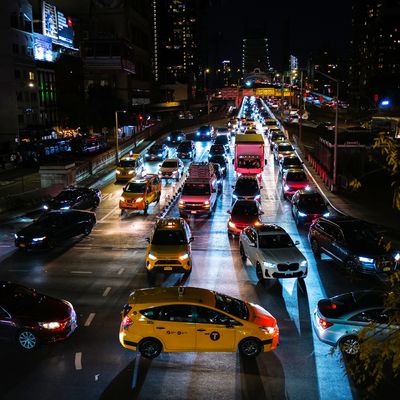
After a half-decade of litigation and delays, congestion pricing is now officially a reality for New York City. To drive into Manhattan south of 60th street, most motorists will pay a $9 toll during peak hours and a minuscule $2.25 on late nights and weekends. This is, in some sense, revolutionary: No American city has ever implemented such a tolling scheme, and pricing road-clogging, carbon-monoxide-spewing automobiles in a central business district that is inordinately accessible by public transportation is a refreshing example of local governance behaving logically for once.
Congestion pricing is not popular. It has polled poorly statewide, and neither Mayor Eric Adams nor Governor Kathy Hochul is terribly excited about its implementation. Neither Democrat held any genuine power when the legislation was passed in 2019: Adams was the Brooklyn borough president, mildly supportive then, and Hochul was Andrew Cuomo’s neutered lieutenant governor. Cuomo has backed away from the legislation he once supported, calling for an indefinite pause as he mulls his own mayoral bid, which would represent his attempted comeback from the numerous sexual-harassment and assault allegations that forced him from office in 2021. Hochul already delayed the program in June, plainly calculating it was better for congressional Democrats running in the suburbs to start tolling motorists in January.
The many opponents of congestion pricing — outer-borough and suburban Democrats and Republicans; virtually every politician in New Jersey, from Governor Phil Murphy on down — have had some good-faith critiques to offer, like the MTA’s chronic inability to manage budgets and the lack of substantial transportation upgrades offered for transit deserts. But the opposition has long grown unhinged. Egged on by the New York Post and local broadcast TV, which have both incessantly agitated against the tolling plan for multiple years, they’ve promised nothing short of a Manhattan apocalypse. Broadway will die, small businesses will shut down, and the city will careen right back to its fiscal-crisis-era nadir, they claim. The firefighters union has outright said that more people will die. One Republican City Councilmember, Vickie Paladino, told her followers on social media that a “high-powered green laser pointer” could destroy a tolling camera. Joking-not-joking, she said one could be had on eBay for under $30.
Complaints about the economic burden of the $9 toll can only be taken seriously for so long. For one, it’s $6 less than the original proposed toll, thanks to Hochul’s half-year of waffling. Partial refunds are available for those who already travel through tolled crossings like the Lincoln and Holland tunnels. Drivers who make under $50,000 and drive to work can get a 50 percent discount after their first ten trips each month. Vehicles transporting people with disabilities, as well as emergency and certain government vehicles, are exempt.
A very small number of commuters actually need to drive to Manhattan every weekday for work. And for those who are traveling for pleasure — for Broadway, a museum visit, or dinner with friends — the reality is that a $9 charge is going to be an absurdly small cost of any kind of Manhattan excursion. Have the shrillest congestion-pricing detractors been out lately? Try getting a beer or a burger south of 60th street; $9 is barely covering the former and definitely not the latter. Most food carts are already charging close to $10 for basic fare, like chicken over rice. Broadway tickets can run $100 or more, and parking for even one hour in any Manhattan garage will easily exceed the price of the toll. If you are driving into Manhattan for fun, you are baking in costs that will, in all likelihood, exceed $70 or $80. And that’s a very conservative estimate.
Will congestion pricing offer more revenue for the MTA? Absolutely. Will the MTA reform its notoriously awful spending practices and allocate that money reasonably? To be determined. Will the tolls significantly cut down on congestion in Manhattan? Possibly. some motorist behavior will change, but a $9 toll — even if it’s set to rise in subsequent years — isn’t a tremendous deterrent. If you enjoy driving into Manhattan already, you might just eat the $9 and call it the cost of doing business. Or perhaps $9 will be just enough to nudge you onto a bus or train. That’s the MTA’s hope, and it is a reasonable one.
The progressive politicians and transit advocates who championed congestion pricing have every right to celebrate. But it’s important, too, to put this policy victory into context. It took more than five years to turn tolling cameras on. More than a century ago, entire subway lines could be expanded in that period of time. The Hugh L. Carey Tunnel, then known as the Brooklyn-Battery Tunnel, was finished in a decade, and that was only because of delays incurred for material shortages during World War II. Cities across the world, meanwhile, easily bolster their mass-transit grids with little fuss. A pricing scheme for driving into Manhattan should be a start, and the MTA must begin to dream much bigger. Hochul and her MTA chair, Janno Lieber, have offered decent proposals, like an expansion of the second Avenue subway to East Harlem and the Interborough Express, a rail line on an existing freight track that could make commuting between Brooklyn and Queens substantially easier. If the MTA can finish either of these projects in the next decade — a reasonable goal for any other global transit authority — New Yorkers will have less of a reason to doubt the tolls on their streets. Deliver for the people, and the gripes will begin to vanish.




























